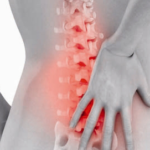Rehabilitation after removal of a hernia of the spine
Operations on the spine are always dangerous, because the postoperative period is of great importance for maintaining the normal function of the spinal column and the life of the patient. A herniated disc does not always require surgical treatment, but when there are indications, it is no longer possible to postpone the operation, because the pathology can lead to disability.
Removal of a diseased disc is only the beginning of a long-term restoration of normal motor activity, and even more depends on the rehabilitation period than on the operating technique.
Life after the operation changes somewhat, but if the patient wants to forget about problems with the spine, this is a necessary measure.
Rehabilitation after removal of a spinal hernia includes not only therapeutic measures, but also a change in lifestyle to eliminate risk factors. If before the operation a person was engaged in heavy physical work or suffered from obesity, after treatment it will be necessary to review the activities and acquire new good habits that will contribute to a speedy recovery and help prevent relapse.
Recovery steps
Recovery after surgery to remove a hernia of the spine is conventionally divided into three periods: early (2 weeks), late (8 weeks), delayed (lifelong). The early stage of rehabilitation includes measures aimed at eliminating pain, normal wound healing and creating psychological comfort. The late period lasts up to 8 weeks, its main goal is adaptation to self-service.
The delayed stage continues throughout life, because the operation affects the state of the musculoskeletal system, the spine becomes susceptible to various pathologies, and there is always a risk of a recurrence of the disease, which is important to prevent.
Rehabilitation after removal of an intervertebral hernia in each case pursues the same goals, but other methods are used to achieve them. The early postoperative period will be similar for everyone, when the patient stays in bed for 1-5 days, while he needs to constantly wear a corset, you can not sit and make sudden movements.
In surgery, the approach to recovery in the late period depends on such factors:
- operation technique - removal of a hernia can be performed by an open and laparoscopic method, as well as by minimally invasive methods, including laser vaporization, the risk of recurrent disease and the duration of rehabilitation depend on this;
- age - in young people, recovery is faster, the elderly require more attention from a rehabilitator;
- general state of health - after surgery to remove an intervertebral hernia, hidden pathologies that require treatment may worsen, otherwise they may provoke a relapse;
- complications - in the early and late period after removal of a herniated disc, complications from the spine and other organs may occur.
Rehabilitation after surgery to remove the intervertebral disc is based on an individual and comprehensive approach.
The first months the patient is monitored by the surgeon, studies are carried out to monitor the condition and timely detection of complications. The specialist prescribes medicines and physiotherapeutic procedures, without which rehabilitation will be painful and long. In addition to the surgeon, the patient is monitored by a rehabilitation specialist and a neurologist.
A stable rehabilitation period is a guarantee of recovery and a return to a normal life with the possibility of self-service. Prevention of re-hernia after surgery is not limited to the prescribed course of treatment, you will have to give up a lot in order to soon feel freedom of movement without pain.
Contraindications after hernia removal
What not to do in the early period:
- sit down (trips in public transport are best avoided, but if necessary, you need to ride only while standing);
- lift more than 3 kg;
- engage in active sports, ride a bicycle;
- drink alcohol, smoke;
- constantly wear a postoperative belt (it is allowed to wear it for 3-4 hours);
- do massage and take a course of manual therapy.
What not to do in the late period:
- perform physical work without prior warm-up;
- stay in one position for a long time;
- make long trips in public transport;
- continue to wear a corset only to alleviate the condition (this leads to muscle atrophy);
- supercool the back, fall under the draft;
- lift more than 7-8 kg;
- engage in extreme sports.
Every few hours, the back needs to be given rest, relax the muscles, lying on a hard surface.
Wearing a bandage will also help in this, it is not necessary to put on a belt for a lying patient for the first few days, but when a person begins to walk and perform simple exercises, a corset is required. The doctor will prescribe an individual mode of wearing it, give recommendations on the duration of its use and choice, and also tell you what to do to strengthen the back muscles.
Goals of rehabilitation
A few weeks after the operation to remove the intervertebral hernia, pain and the inability to do usual things are disturbing, therefore, along with drug therapy, psychological support is needed not only from the medical staff, but also from close people.
If the goals of the operation are to get rid of the cause of pain and prevent complications leading to disability, then rehabilitation sets itself much more tasks.
The goals of early and late rehabilitation after removal of a spinal hernia:
- elimination of pain syndrome and neurological symptoms;
- normalization of the patient's well-being, elimination of concomitant disorders;
- restoration of mobility of the spinal column;
- the return of the possibility of full self-service;
- return to moderate exercise.
Anesthesia
For pain relief after removal of a hernia, drugs for oral administration and agents for intravenous, injection and epidural administration are used.
Methods of pain relief after surgery to remove the intervertebral hernia:
- Tablets for oral administration. Non-steroidal anti-inflammatory drugs (Ibuprofen, Ketoprofen, Diclofenac). Relieve pain, inflammation, tissue swelling. Side effects develop in 2% of patients: nausea, heartburn, subcutaneous small hemorrhage. Paracetamol is prescribed to reduce fever and relieve pain. Narcotic analgesics (Tramadol, Codeine) are indicated for severe pain syndrome, they last up to 7 hours.
- Solutions for injections. Strong painkillers are administered intravenously and intramuscularly. Preparations Morphine, Fentanyl are prescribed exclusively by a doctor, the funds begin to act immediately after administration.
- Local funds. Ointments, gels, compresses are used as adjuvants for moderate pain. Preparations for topical application are safe and have a small number of adverse reactions.
Physiotherapy
In the late period of rehabilitation, for the prevention of consequences and relapse, the following is prescribed:
- interstitial electrical stimulation - anesthetizes, relieves spasm, eliminates tissue compression, removes the inflammatory process;
- ultrasound therapy - accelerates tissue regeneration, stimulates nutritional processes, saturates with oxygen, removes swelling and pain;
- magnetotherapy - activates metabolic processes, helps to reduce swelling, restores the mobility of the patient's back;
- mud therapy - has anti-inflammatory, anti-edematous, analgesic effect;
- phonophoresis and electrophoresis - delivers medicinal substances directly to the damaged spine;
- EHF - increases muscle tone, relieves inflammation, reduces pain.
Bandage and physical activity
Exercise therapy after removal of the intervertebral hernia is indicated in the late period of rehabilitation, but physiotherapy exercises should become part of life, regardless of the condition of the spine. All exercises are aimed at restoring muscle tone, strengthening the muscles of the back, abs, arms and legs.
The medical complex is also necessary to improve blood circulation in the diseased department, which will prevent stagnant and adhesive processes.
Exercise therapy has a general strengthening effect, increases the elasticity and strength of the ligaments. A hernia of the spine can recur, and even several times, which significantly affects the prognosis of the possibility of self-care. Severe consequences are possible if physical therapy is ignored, when a person continues to lead a habitual lifestyle that is harmful to the health of the back. A relapsing disease is an extremely dangerous disorder, with which one has to deal with treatment and recovery for most of one's life. Exercise therapy is a way to strengthen the muscular corset of the spine, which will become an important condition for the prevention of relapse.
Features of physical therapy after removal of an intervertebral hernia:
- the first few days, all exercises are performed under the supervision of a doctor;
- the load increases gradually, classes begin with a warm-up;
- if pain occurs, exercise should be abandoned until health improves;
- in case of increased pain when performing a separate movement, it must be excluded;
- severe increasing pain should be the reason for going to the doctor;
- exercises are performed on a special soft mat at home or in the gym;
- from auxiliary devices, you can use a horizontal bar, light dumbbells, fitball.
Kinesitherapy is a treatment with certain movements, which are selected individually by the instructor. For this, special simulators are used that allow you to use the necessary muscle groups. Kinesiotherapy allows you to eliminate the compression of the nerve roots by increasing the space between the vertebrae.
During the exercise, you need to wear a supporting corset, which eliminates accidental injury and sudden movements. It should be used only during classes and when pain appears, because its long use will lead to muscle atrophy, which will only aggravate the condition, provoking a relapse.
In addition, it is useful to engage in water procedures, but ordinary swimming in the pool will be ineffective, and if you cannot keep the body on the water correctly, it will also be harmful. The doctor may prescribe underwater spinal traction, which is useful for improving mobility and increasing range of motion in the affected area.
Regardless of how long the sick leave lasts from the moment of surgery, it can be extended several times, which will depend on the results of the studies and the quality of recovery.
After removing the hernia, it is recommended to undergo a course of treatment once a year in specialized centers that offer various wellness treatments: massage, therapeutic baths, acupuncture and many others. But in the first months of recovery, it is better not to change the climate in order to avoid the difficult adaptation of a weakened organism.










